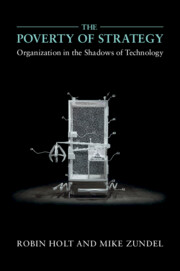Introduction: Strategy as the Basic Question of Organization?
Published online by Cambridge University Press: 14 July 2023
Summary
Introduction: ‘Strategy and as the basic question of organization?’ provides an overview of ideas, themes and concepts that find fuller exploration in subsequent chapters. We set the scene by considering the grounding importance of strategy as an organizational practice: enacting the struggle to see outside the measured orbits by which sight is habitually and theoretically confined to a representation.
Keywords
Information
- Type
- Chapter
- Information
- The Poverty of StrategyOrganization in the Shadows of Technology, pp. 1 - 12Publisher: Cambridge University PressPrint publication year: 2023
